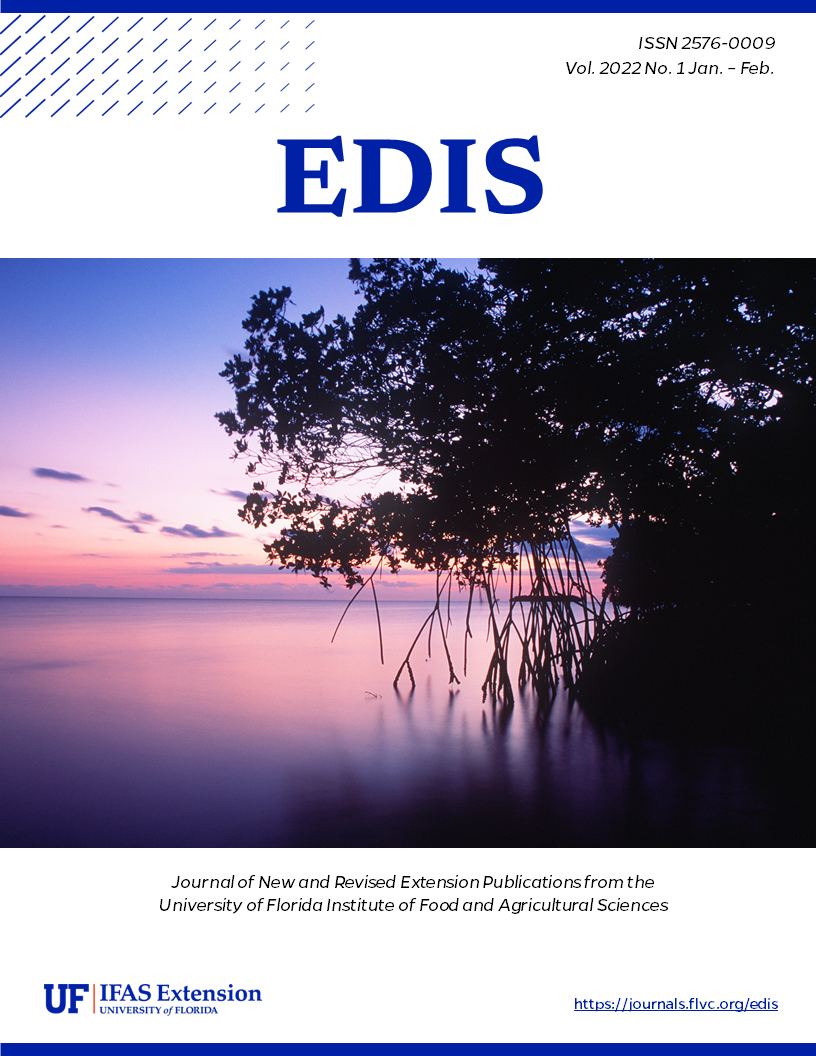Abstract
Not only is fish a good source of protein, but it also provides essential fatty acids such as omega-3, vitamins such as vitamin D, and minerals such as selenium. However, consumers are concerned about exposure to mercury through fish consumption. The degree of exposure to mercury depends on both the amount and the type of fish consumed. Additionally, recent studies have shown that Se can prevent mercury poisoning. To better understand the risk of mercury exposure through seafood consumption, understanding selenium-mercury interaction is useful. This new 4-page document is the first in a "Fish and Human Nutrition" series, which seeks to help consumers make a knowledge-based decision when choosing their seafood. Written by Razieh Farzad and Jeanette Andrade and published by the UF/IFAS Food Science and Human Nutrition Department.
https://edis.ifas.ufl.edu/fs437
References
Behne, D., Pfeifer, H., Rothlein, D., Kyriakopoulos, A., 2000. Cellular and subcellular distribution of selenium and selenium-containing proteins in the rat. In: Roussel, A.M., Favier, A.E., Anderson, R.A. (Eds.), Trace Elements in Man and Animals 10. Kluwer Academic/Plenum Publishers, New York, pp. 29-34. https://doi.org/10.1007/0-306-47466-2_5
Berry, M. J., and N. V. Ralston. 2008. "Mercury toxicity and the mitigating role of selenium." Ecohealth 5 (4):456-9. https://doi.org/10.1007/s10393-008-0204-y
Coppinger, Ruth J., and Alan M. Diamond. 2001. "Selenium deficiency and human disease." In Selenium: Its Molecular Biology and Role in Human Health, edited by Dolph L. Hatfield, 219-233. Boston, MA: Springer US. https://doi.org/10.1007/978-1-4615-1609-5_18
Combs Jr., G.F., Lu, J., 2001. Selenium as a cancer preventive agent. In: Hatfield, D.L. (Ed.), Selenium. Kluwer Academic Publishers, Hingham, Maine, pp. 205-217. https://doi.org/10.1007/s13167-010-0033-2
Davidson, P.W., Myers, G.J., Cox, C., Axtell, C., Shamlaye, C., Sloane-Reeves, J., Cernichiari, E., Needham, L., Choi, A., Wang, Y., Berlin, M., Clarkson, T.W., 1998. Effects of prenatal and postnatal methylmercury exposure from fish consumption on neurodevelopment: outcomes at 66 months of age in the Seychelles Child Development Study. JAMA 280, 701-707. https://doi.org/10.1001/jama.280.8.701
Farzad, R., Kuhn, D. D., Smith, S. A., O'Keefe, S. F., Ralston, N. V. C., Neilson, A. P., & Gatlin, D. M. 2019). Trace minerals in tilapia fillets: Status in the United States marketplace and selenium supplementation strategy for improving consumer's health. PLoS One, 14(6), e0217043. https://doi.org/10.1371/journal.pone.0217043
George, G.N., MacDonald, T. C., Korbas, M., Singh, S.P., Myers, G.J., Watson, G.E, et al ,2011. The chemical forms of mercury and selenium in whale skeletal muscle. Metallomics, 3, pp. 1232-1237. https://doi.org/10.1039/c1mt00077b
Grandjean P, Weine P, White RF, et al.,1997 Cognitive deficit in 7-year-old children with prenatal exposure to methylmercury. Neurotoxicol Teratol. 9: 417-28. https://doi.org/10.1016/S0892-0362(97)00097-4
Hibbeln, J.R., Davis, J.M., Steer, C., Emmett, P., Rogers, I., Williams, C., Golding, J., 2007. Maternal seafood consumption in pregnancy and neurodevelopmental outcomes in childhood (ALSPAC study): an observational cohort study. Lancet 369, 578-585. https://doi.org/10.1016/S0140-6736(07)60277-3
Kaneko JJ, Ralston. N. (2007). Selenium and mercury in pelagic fish in the central north pacific near Hawaii. Biol Trace Elem Res, 119(3), 242-254. https://doi.org/10.1007/s12011-007-8004-8
Khalili Tilami S, Sampels S. Nutritional value of fish: lipids, proteins, vitamins, and minerals. Rev Fish Sci Aquac 2018; 26(2): 243-53. https://doi.org/10.1080/23308249.2017.1399104
Kris-Etherton, P.M., Harris, W.S., Appel, L.J. Fish consumption, fish oil, omega-3 fatty acids, and cardiovascular disease. Circulation. 2002; 106:2747-57. https://doi.org/10.1161/01.CIR.0000038493.65177.94
Li, G. S., Wang F., Kang, D., Li, C., 1985. "Keshan disease: an endemic cardiomyopathy in China." Hum Pathol 16 (6):602-9. https://doi.org/10.1016/S0046-8177(85)80110-6
Myers, G.J., Davidson, P.W., 1998. Prenatal methylmercury exposure and children: neurologic, developmental, and behavioral research. Environ. Health Perspect. 106, 841-847. https://doi.org/10.1289/ehp.98106841
Oken, E., Østerdal, M.L., Gillman, M.W., Knudsen, V.K., Halldorsson, T.I., Strøm, M., Bellinger, D.C., Hadders-Algra, M., Fleischer-Michaelsen, K., Olsen, S.F., 2008. Associations of maternal fish intake during pregnancy and breastfeeding duration with attainment of developmental milestones in early childhood: a study from the Danish National Birth Cohort. Am. J. Clin. Nutr. 88, 789-796. https://doi.org/10.1093/ajcn/88.3.789
Ralston, N. V. C., R. Ralston, and L. J. Raymond. 2016. Selenium Health Benefit Values: Updated Criteria for Mercury Risk Assessments. Biol Trace Elem Res 171 (2):262-9. https://doi.org/10.1007/s12011-015-0516-z
Ralston N.V. C., Kaneko J. J, L. J. Raymond. 2019. Selenium Health Benefit Value provide a reliable index of seafood benefits vs. risks. J Trace Elem Med Biol. 55(2019)50-57. https://doi.org/10.1016/j.jtemb.2019.05.009
Ralston N.V. C., L. J. Raymond. 2007, Selenium and Mercury in Pelagic Fish in Central North Pacific Near Hawaii. Biol Trac Elem Res. 119(3):242-54. 0.1007/s12011-007-8004-8 https://doi.org/10.1007/s12011-007-8004-8
Ramauge, M., Pallud, S., Esfandiari, A., Gavaret, J.M., Lennon, A.M., Pierre, M., Courtin,F., 1996. Evidence that type III iodothyronine deiodinase in rat astrocyte is a selenoprotein. Endocrinology 137, 3021-3025. https://doi.org/10.1210/en.137.7.3021
Roy, M., Kiremidjian-Schumacher, L., Wishe, H.I., Cohen, M.W., Stotzky, G., 1995. Supplementation with selenium restores age-related decline in immune cell. Proc Soc Exp Bio Med 209(4):369-75. https://doi.org/10.3181/00379727-209-43909
Spiller H. A. Rethinking mercury: the role of selenium in pathophysiology of mercury toxicity. 2017. J. Clin Toxicol 56(5):313-326 https://doi.org/10.1080/15563650.2017.1400555
Tapiero, H., Townsend, D.M., Tew, K.D., 2003.The oxidant role of selenium and seleno-compound. Biomed Pharmacother. May-Jun; 57(3-4): 134-144. PNCID: PMC6361120 https://doi.org/10.1016/S0753-3322(03)00035-0
The U.S. Department of Agriculture and the U.S. Department of Health and Human Services Dietary Guidelines for Americans, 2010. www.cnpp.usda.gov/DGAs2010-PolicyDocument.htm and www.ars.usda.gov

